Swachh Bharat mission
Swachh Bharat Abhiyan (SBA) or Swachh Bharat Mission (SBM) is a nation-wide campaign in India for the period 2014 to 2019 that aims to clean up the streets, roads and infrastructure of India's cities, towns, urban and rural areas. The campaign's official name is in Hindi and translates to "Clean India Mission" in English. The objectives of Swachh Bharat include eliminating open defecation through the construction of household-owned and community-owned toilets and establishing an accountable mechanism of monitoring toilet use. Run by the Government of India, the mission aims to achieve an "open-defecation free" (ODF) India by 2 October 2019, the 150th birth anniversary of Mahatma Gandhi,[1] by constructing 100 million toilets in rural India at a projected cost of ₹1.96 lakh crore (US$28 billion). The mission will also contribute to India reaching Sustainable Development Goal 6 (SDG 6), established by the UN in 2015.
| Swachh Bharat mission (SBM) | |
|---|---|
| Swachh Bharat Abhiyan (SBA) | |
 | |
.jpg) PM Modi launches Swachh Bharat Abhiyan | |
| Slogan | One step towards cleanliness |
| Country | India |
| Prime Minister(s) | Narendra Modi |
| Launched | Raj Ghat; 2 October 2014 |
| Status | Active |
| Website | swachhbharat |
The campaign was officially launched on 2 October 2014 at Rajghat, New Delhi by Prime Minister Narendra Modi. It is India's largest cleanliness drive to date with three million government employees and students from all parts of India participating in 4,043 cities,towns and rural areas.. Modi has called the campaign Satyagrah se Swachhagrah in reference to Gandhi's Champaran Satyagraha launched on 10 April 1916.[2]
The mission has two thrusts: Swachh Bharat Abhiyan ("gramin" or 'rural'), which operates under the Ministry of Drinking Water and Sanitation; and Swachh Bharat Abhiyan ('urban'), which operates under the Ministry of Housing and Urban Affairs.[3][4][5][6]
As part of the campaign, volunteers, known as Swachhagrahis, or "Ambassadors of cleanliness", have promoted indoor plumbing and community approaches to sanitation (CAS) at the village level.[2] Other non-governmental activities include national real-time monitoring and updates from non-governmental organizations (NGOs) such as The Ugly Indian, Waste Warriors, and SWaCH Pune (Solid Waste Collection and Handling) that are working towards its ideas of Swachh Bharat.[7]
The government has constructed 11 million toilets since 2014.[1] Many people continue to not use toilets despite having them.[8] The campaign has been criticized for using coercive approaches to force people to use toilets.[9][10] Many households have been threatened with a loss of benefits such as access to electricity or food entitlements through the public distribution system. [11]
Background
Open defecation and contamination of drinking and bathing water has been an endemic sanitary problem in India.[12][13] In 2014, India was the country with the highest number of people practicing open defecation, around 530 million people.[14]
Launch
.jpg)
Swachh Bharat Abhiyan campaign, launched on 2 October 2014 on Gandhi Jayanti, aims to eradicate open defecation by 2 October 2019, the 150th anniversary of the birth of Mahatma Gandhi, by constructing 90 million toilets in rural India at a projected cost of ₹1.96 lakh crore (US$28 billion).[15][16][17] The national campaign spans 4,041 statutory cities and towns.[18][19] conceived in March 2014 at a sanitation conference organised by UNICEF India and the Indian Institute of Technology as part of the larger Total Sanitation Campaign, which the Indian government launched in 1999.[20]
Previous sanitation campaigns
A formal sanitation programme was first launched in 1954, followed by Central Rural Sanitation Programme in 1986, Total Sanitation Campaign (TSC) in 1999 and Nirmal Bharat Abhiyan in 2012.[21][22][23][24] A limited randomized study of eighty villages in rural (Madhya Pradesh) showed that the TSC programme did modestly increase the number of households with latrines, and had a small effect in reducing open defecation. However, there was no improvement in the health of children."[25][26] The earlier "Nirmal Bharat Abhiyan" rural sanitation program was hampered by the unrealistic approach.[27][28][29] Consequently, Nirmal Bharat Abhiyan was restructured by Cabinet approval on 24 September 2014 as Swachh Bharat Abhiyan.[19] The rural household toilet coverage in India increased from 1% in 1981 to 11% in 1991, to 22% in 2001, to 32.7% in 2011.[30]
Initiatives
"Swachh Bharat Swachh Smarak" campaign was launched in December 2014.[31]
Structure
Finance
Swachh Bharat Abhiyan is expected to cost over ₹620 billion (US$9.0 billion).[6][32] The government provides an incentive of ₹12,000 (US$170) for each toilet constructed by a rural family.[15] An amount of ₹90 billion (US$1.3 billion) was allocated for the mission in the 2016 Union budget of India.[18][33] The World Bank provided a US$1.5 billion loan and $25 million in technical assistance in 2016 for the Swachh Bharat Mission to support India's universal sanitation initiation.[17] The programme has also received funds and technical support from the World Bank, corporations as part of corporate social responsibility initiatives, and by state governments under the Sarva Shiksha Abhiyan and Rashtriya Madhyamik Shiksha Abhiyan schemes.[16]
Planned initiatives
.jpg)
The Government appointed CPWD with the responsibility to dispose of waste from Government offices.[34] The Ministry of Railways planned to have the facility of cleaning on demand, clean bed-rolls from automatic laundries, bio-toilets, dustbins in all non-AC coaches.[35] The Centre will use its Digital India project in conjunction with the Swachh Bharat Abhiyan to have solar-powered dustbins, which send alerts to sanitation crew once they are full.[36] The Swachh Bharat Swachh Vidyalaya campaign was launched by the Minister of Human Resource Development, Government of India by participating in the cleanliness drive along with the school's teachers and students.[37][38]
Promotional campaigns
Selected public figures
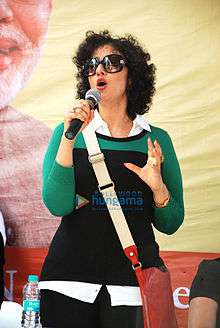
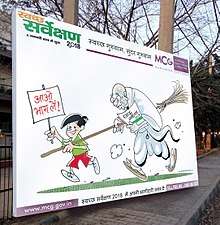
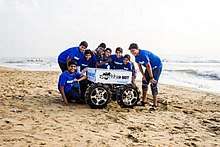
Prime Minister Modi selected following public figures to propagate this campaign.[39][40] They are:
- Sachin Tendulkar (Cricketer)
- Priyanka Chopra (Actress)
- Baba Ramdev(Yoga guru)
- Salman Khan (Actor)
- Vidya Balan (Actress)
- Shashi Tharoor(Politician)
- Team : TMKOC
- Amitabh Bacchan (Actor)
- Mridula Sinha(Politician)
- Kamal Hasan (Actor)
- Virat Kohli (Cricketer)
- M S Dhoni (Cricketer)
Anushka Sharma and the Vice President of India M V Naidu picked up a broom to help clean the cyclone-hit port city of Visakhapatnam, in the southern state of Andhra Pradesh, as part of the cleanliness campaign.[41][42]
Brand Ambassadors
On 2 October 2014, Prime Minister Modi nominated following people as Brand Ambassadors:
- Sourav Ganguly (cricketer)
- Kiran Bedi (Former IPS officer)
- Padmanabha Acharya (Former Nagaland Governor)
- Sonal Mansingh (Classical dancer)
- Ramoji Rao (Eenadu group)
- Aroon Purie (India Today group)
He also nominated a number of organisations, including the Institute of Chartered Accountants of India, Eenadu and India Today as well as the dabbawala of Mumbai, who deliver home-made food to lakhs of people in the city.More than 3 million government employees and school and college students participated in the drive on the occasion.[43][44]
On 8 November 2014, Prime Minister carried the message to Uttar Pradesh and nominated another set of nine people for that state.[45][46]
- Akhilesh Yadav (Politician)
- Swami Rambhadracharya
- Manoj Tiwari (Politician)
- Dilkeshvar Kumar (Engineer)
- Mohammad Kaif (Cricketer)
- Deviprasad Dwivedi(Teacher)
- Raju Srivastava (Comedian)
- Suresh Raina (Player)
- Kailash Kher(Music composer)
On 5 January 2015, the minister in-charge nominated followed Telugu icons as brand ambassadors.[47][48]
- Rajyogini (Brahmakumaris Dadi Janki)
- Pawan Kalyan[49]
- S. P. Balasubrahmanyam
- Amala (actress)
- K. Kavitha[49]
- G V K Reddy
- Suddala Ashok Teja
- P Gopichand (sports)
- Humpy Koneru
- Galla Jayadev
- Nithin
- V. V. S. Laxman (sports)
- J. Rameshwar Rao
- Shivlal Yadav
- B. V. R. Mohan Reddy
- Akshay Kumar
- Lakshmi Manchu[50]
From later dates the following public icons were invited to join and support the mission as brand ambassadors
Other notable activities
A Swachh Bharat Run, attended by 1,500 runners, was organized at the Rashtrapati Bhavan on 2 October 2014.[55][56]
Kunwar Bai Yadav lived in a village in Dhamtari district and sold seven of her goats to raise the money to build a toilet at her house at age 106 in 2016. She was declared a mascot of the campaign and visited by Prime Minister Narendra Modi.
Inspired by the Clean India Mission, a robot named Swachh Bot was built by a maker community in Chennai to clean the wastes on Besant Nagar beach.[15][57]
Performance monitoring
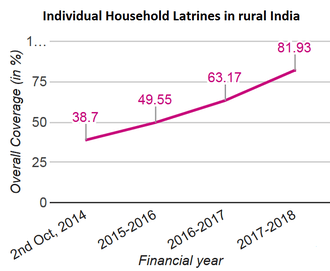
Swachh Bharat Mission (SBM) Mobile app is being used by people and Government organisations for achieving the goals of Swachh Bharat Mission.[58] For this the government of India is bringing awareness to the people through advertisements.[59]
In 2017, the national sanitation coverage rose to 65% from 38.7% on Oct 2, 2014 before the start of the campaign.[60] It was 90% in August 2018.[61] 35 states/Union Territories, 699 districts and 5.99 lakh villages were declared Open Defecation Free (ODF) by 25 September 2019.
The cities and towns which have been declared ODF stood at 22 percent and the urban wards which have achieved 100 percent door-to-door solid waste collection stood at 50 percent. The number of Swachhagrahi volunteers working across urban local bodies rose to 20,000, and those working in rural India rose to more than a lakh. The number of schools with separate toilet facilities for girls rose from 0.4 million (37 percent) to almost one million (91 percent).[60]
Swachh Sarvekshan annual cleanliness survey
Swachh Sarvekshan, commissioned by Ministry of Urban Development and carried out by Quality Council of India, is an extensive sanitation survey across several hundred cities to check the progress and impact of Swachh Bharat Abhiyan and to foster a spirit of competition among the cities. The performance of each city is evaluated on six parameters:-
- Municipal solid waste, sweeping, collection and transportation
- Municipal solid waste, processing, and disposal of solid waste
- Open defecation free and toilets
- Capacity building and eLearning
- Provision of public toilets and community toilets
- Information, education and communication, and behavior change
2016 Swachh Sarvekshan survey
The Swachh Sarvekshan-2016 ranks of 73 cities surveyed are:[62][63][64][65]
Cleanest ten cities:
- Indore (Madhya Pradesh)
- Tiruchirappalli (Tamil Nadu)
- Chandigarh
- New Delhi
- Visakhapatnam
- Surat (Gujarat)
- Rajkot (Gujarat)
- Gangtok (Sikkim)
- Pimpri-Chinchwad (Maharashtra)
- Greater Mumbai (Maharashtra)
Ten least clean cities (at the bottom of the list):
- 64. Kalyan Dombivili (Maharashtra)
- 65. Varanasi (Uttar Pradesh)
- 66. Jamshedpur (Jharkhand)
- 67. Ghaziabad (Uttar Pradesh)
- 68. Raipur (Chhattisgarh)
- 69. Meerut (Uttar Pradesh)
- 70. Patna (Bihar)
- 71. Itanagar (Arunachal Pradesh)
- 72. Asansol (West Bengal)
- 73. Dhanbad (Jharkhand)
2017 Swachh Sarvekshana survey
Swachh Sarvekshan 2017 was conducted across 500 cities between 4 January 2017 and 7 February 2017. The top 10 cities are:[66]
- Indore
- Bhopal
- Vishakhapatnam
- Surat
- Mysore
- Tiruchirapalli
- New Delhi Municipal Council
- Navi Mumbai
- Tirupati
- Vadodara
- coimbatore
Success
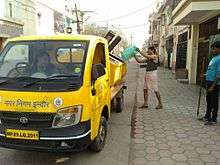
As per an independent survey released by Quality Council of India in August 2017, overall national rural "household access to toilet" coverage increased to 62.5% and usage of toilets to 91.3%, with Haryana topping the national ranking with 99% of households in rural areas covered and usage of toilets of 100%.[67] World Health Organization (WHO) has in its report stated that at least 180,000 diarrhoeal deaths were averted in rural India since the launch of the Swachh Bharat Mission.[68] According to a survey carried out in 2018 and published in 2019 by National Statistical Office (NSO), 71% of rural households had access to toilets as of 2018. Though this was at oods with the Indian government's claim in 2019 that 95% of rural households had access to toilets, NSO's numbers still indicated a significant improvement over the situation during the previous survey period in 2012, when only 40% of rural households had access to toilets.[69]
Criticism
Some newspaper articles suggest that open defecation has not fallen as rapidly and sustainably as the government claims.[70][71][72] As per an independent research report published by ABP News, Haryana disbursement of incentives under the Swachh Bharat Mission (Urban) in the state of Haryana has been made arbitrarily by ignoring the government guidelines of Swachh Bharat Mission (Urban).[73] In 2015, hundreds of thousands of Indian people were still employed as manual scavengers in emptying bucket toilets and pit latrines.[74][75][76]
See also
- Community-led total sanitation
- Digital India
- Electronic Toilet
- India.gov.in
- Jodie Underhill
- List of cleanest cities in India
- List of cleanest railway stations in India
- MyGov.in
- Toilet: Ek Prem Katha, feature film
- Water supply and sanitation in India
References
Citations
- "An Indian village's fight to take the 'poo to the loo'". AFP. 2 October 2018. Archived from the original on 3 October 2018.
- "Satyagraha to Swachhagrah: Narendra Modi addresses rally in Champaran". Business Standard. 10 April 2018. Archived from the original on 12 April 2018.
- "Swachh Bharat Mission - Gramin, Department of Drinking Water and Sanitation, Ministry of Jal Shakti".
- "Swachh Bharat campaign should become mass movement: Narendra Modi". The Economic Times. Retrieved 2 October 2014.
- "PM reviews preparations for launch of Mission Swachh Bharat". Retrieved 7 October 2014.
- "Swachh Bharat: PM Narendra Modi launches 'Clean India' mission". Zee News. Retrieved 2 October 2014.
- "SWACH". Archived from the original on 22 August 2009.
- https://riceinstitute.org/research/changes-in-open-defecation-in-rural-north-india-2014-2018-2/
- "Swachh Bharat Mission: other name for coercion and deprivation". www.downtoearth.org.in. Retrieved 23 August 2019.
- "Dalits, Adivasis Most Likely to Face Coercion to Stop Open Defecation, Study Finds". The Wire. Retrieved 23 August 2019.
- "DCoercion, Construction, and 'ODF paper pe': Swachh Bharat According to Local Officials". The India Forum. Retrieved 18 September 2019.
- Spears, Dean; Ghosh, Arabinda; Cumming, Oliver (2013). "Open Defecation and Childhood Stunting in India: An Ecological Analysis of New Data from 112 Districts". PLoS ONE. 8 (9): e73784. doi:10.1371/journal.pone.0073784. PMC 3774764. PMID 24066070.
- "India has 60.4 per cent people without access to toilet: Study". The Indian Express. 19 November 2015. Archived from the original on 18 November 2017.
- Grojec, Anna, ed. (2017). Progress on Drinking Water, Sanitation and Hygiene: 2017 Update and SDG Baselines. Geneva: World Health Organization (WHO) and the United Nations Children’s Fund (UNICEF). Archived from the original on 30 January 2018.
- "MDWS Intensifies Efforts with States to Implement Swachh Bharat Mission", Business Standard, 18 March 2016 (press release)
- "Swachh Bharat Abhiyaan: Government builds 7.1 lakh toilets in January". timesofindia-economictimes.
- "India, World Bank sign $1.5 billion loan pact for Swachh Bharat Mission", The Economic Times, 30 March 2016
- "Budget 2016: Swachh Bharat Abhiyan gets Rs 9,000 crore", The Economic Times, 29 February 2016
- "Restructuring of the Nirmal USA Abhiyan into Swachh Bharat Mission". pib.nic.in. Retrieved 12 June 2017.
- Poo2Loo to break open defecation taboo
- Mridula Sinha & Dr. R.K. Sinha 2016, pp. 21-22.
- "Time to clean up your act", Hindustan Times
- "Nirmal Bharat Abhiyan failed to achieve its desired targets: CAG jdjgjfi", Mint, 16 December 2015
- "Salient Features of Nirmal Bharat Abhiyan". Biharprabha News. Retrieved 17 December 2014.
- Patil, Sumeet; Arnold, Benjamin; Salvatore, Alicia; Briceno, Bertha; Ganguly, Sandipan; Colford Jr., John; Gertler, Paul (26 August 2014). "The Effect of India's Total Sanitation Campaign on Defecation Behaviors and Child Health in Rural Madhya Pradesh: A Cluster Randomized Controlled Trial". PLOS Medicine. 11: e1001709. doi:10.1371/journal.pmed.1001709. PMC 4144850. PMID 25157929.
- "An Open Letter in response to the World Development Report 2019". Retrieved 23 March 2015.
- IRC:India: Unrealistic approach hampers rural sanitation programme Archived 5 October 2008 at the Wayback Machine, 1 June 2007
- Institute of Development Studies:Community-led total sanitation:India
- Benny George, Nirmal Gram Puraskar: A Unique Experiment in Incentivising Sanitation Coverage in Rural India, International Journal of Rural Studies (IJRS), Vol. 16, No. 1, April 2009
- Mridula Sinha & Dr. R.K. Sinha 2016, p. 22.
- Mridula Sinha & Dr. R.K. Sinha 2016, p. 52.
- "PM Modi's 'Swachh Bharat Abhiyan' set for mega launch Thursday; schools, offices gear up for event". Zee News.
- "Modi government mobilises Rs 370 crore under Swachh Bharat Kosh", The Economic Times, 11 March 2016
- "Swachh Bharat: CPWD begins lifting 'zero-value goods' from government offices and buildings", The Economic Times, 17 May 2016
- "'Railway Budget Aligned to PM Modi's Vision for Digital India'", The New Indian Express, 5 March 2016
- "When Swachh Bharat met Digital India: Now solar-powered trash cans to send alerts when full", The Economic Times, 18 March 2016
- Swachch Bharat Swachch Vidhalaya Archived 29 October 2014 at the Wayback Machine
- Swachh Bharat-Swachh Vidyalaya Campaign
- "PM Modi's Swachh Bharat Abhiyan: Anil Ambani dedicates himself to the movement". 2 October 2014. Retrieved 2 October 2014.
- "PM launches Swachh Bharat Abhiyaan". 2 October 2014. Retrieved 2 October 2014.
- "Venkaiah Naidu picked up the broom to clean cyclone-hit port city of Visakhapatnam - indtoday.com - indtoday.com". indtoday.com. Archived from the original on 24 October 2014.
- Naidu picked up the broom to clean cyclone-hit port city of Visakhapatnam
- "Swachh Bharat Abhiyan: PM Narendra Modi to wield broom to give India a new image". The Times of India. Retrieved 2 October 2014.
- "Swachh Bharat campaign is beyond politics, PM Narendra Modi says". The Times of India. Retrieved 2 October 2014.
- "PM India". Prime Minister's Office. 8 November 2014. Retrieved 27 November 2014.
- "Press Information Bureau". Press Information Bureau, Government of India. 8 November 2014. Retrieved 27 November 2014.
- "18 Telugu icons named ambassadors for Swachh Bharat". indiatoday.intoday.in. Retrieved 1 June 2016.
- "18 Telugu People as Swachh Bharat Ambassadors | 9 people each in AP and Telangana as Swachh Bharat Ambassadors". Andhra Pradesh Political News, Telugu Cinema News - APToday. 5 January 2015. Archived from the original on 4 August 2016. Retrieved 1 June 2016.
- admin. "swachh bharat brand ambassador List". Telangana State Portal - Latest News Updates.
- "Lakshmi Manchu Is Telangana Swachh Bharat's Brand Ambassador" Archived 6 September 2015 at the Wayback Machine MovieNewz.in, Retrieved 04.09.2015
- MCG announces Shekhar Gurera as official Brand Ambassador UNI, Jan 30 2018.
- "पार्षदों ने उठाए सवाल- अब निगम के पास जिम्मा, फिर क्यों नहीं हो रही सफाई?". Dainik Bhaskar (in Hindi). 28 August 2018.
- "Rajasthan Patrika Private Limited Ajmer epaper dated Mon, 17 Sep 18". epaper.patrika.com.
- "सड़कों की हालत खराब, बड़े गड्ढे, , गांव से ही बुरी हालत ... रोड पर बीचों-बीच बैठे मवेशी।". www.patrika.com (in Hindi).
- "Swachh Bharat Run organized at Rashtrapati Bhavan". The Times of India.
- "Desi companies beat Facebook in 'Swachh' apps race". The Times of India.
- Sinha, Vipasha (14 February 2015). "Robot joins Clean India mission". The Hindu. ISSN 0971-751X. Retrieved 23 August 2019.
- "Digital India Week: Digital Locker, MyGov.in, and other projects thact were unveiled", The Indian Express, 5 July 2015
- "Swachh Bharat goes hi-tech, govt to track toilet use with iPads". The Hindu. 31 December 2014.
- "At The Half-way Mark", The Indian Express, 31 July 2017
- Swachh Bharat Abhiyan Report Stats, 18 November 2016, archived from the original on 22 May 2016
- DelhiFebruary 15, India Today Web Desk New; February 16, 2016UPDATED:; Ist, 2016 14:25. "Cleanliness ranking for 73 cities is out. Mysuru cleanest, Modi's Varanasi among dirtiest". India Today. Retrieved 23 August 2019.CS1 maint: extra punctuation (link)
- "Cleanliness ranking for 73 cities is out. Mysuru cleanest, Modi's Varanasi among dirtiest", India Today, 15 February 2016
- "Chandigarh Declared Second Cleanest City of India in 2016 Swachh Bharat Survey", Chandigarh Metro
- Nagaon topped 8th cleanest city in India
- "State-wise assessment schedule - Swachh Sarvekshan 2017" (PDF). 10 January 2017. Retrieved 11 May 2017.
- "Kerala, Haryana top sanitation survey", The Hindu, 9 August 2017
- "How Swachh Bharat transformed the way public hospitals function", Hindustan Times, 29 September 2018
- Jebaraj, Priscilla (24 November 2019). "Open defecation-free India: National Statistical Office survey debunks Swachh Bharat claims". The Hindu. ISSN 0971-751X. Retrieved 25 November 2019.
- "Swachh Bharat Mission a failure: Jairam". The Hindu. Special Correspondent. 6 October 2018. ISSN 0971-751X. Retrieved 1 May 2019.CS1 maint: others (link)
- SHARMA, NIDHI (5 June 2018). "Swachh Bharat Abhiyan: Where progress on paper hits quicksand of ground reality". The Economic Times. Retrieved 1 May 2019.
- Pareek, Shabdita (13 November 2017). "UN Dismisses Swachh Bharat Saying It Has Failed To Eliminate Manual Scavenging From India". ScoopWhoop. Retrieved 1 May 2019.
- Satish, Bhasin. "Know How Clean Haryana in Swachh Bharat Mission". ABC Live Haryana. ABC Live Haryana. Retrieved 13 April 2018.
- "Swachh Bharat Abhiyan should aim to stamp out manual scavenging". hindustantimes. 13 July 2015.
- Umesh IsalkarUmesh Isalkar, TNN (30 April 2013). "Census raises stink over manual scavenging". The Times of India. Retrieved 6 September 2015.
- "Manual scavenging still a reality". The Hindu. 9 July 2015. Retrieved 9 September 2015.
Sources
- Sinha, Mridula; Sinha, Dr. R.K., eds. (2016), Swachh Bharat (A Clean India) (First ed.), Prabhat Prakashan, ISBN 978-93-5186-722-7